You’ll uncover that creating an open concept minimalist living room isn’t just about removing walls and decluttering spaces. It’s about crafting an intentional sanctuary that flows naturally and breathes freely. Whether you’re renovating a compact apartment or reimagining a spacious home, these proven design strategies will reshape your living area into an airy retreat. From strategic furniture placement to clever storage solutions, each idea builds upon the next to help you achieve your dream space.
Embrace Natural Light Through Bare Windows
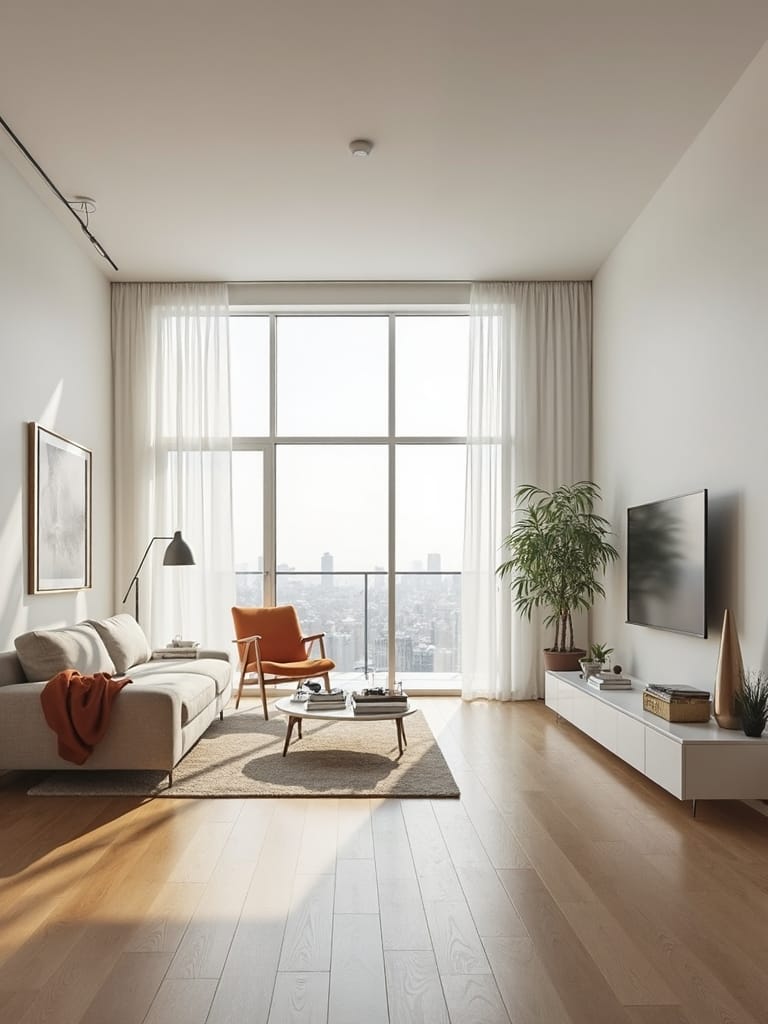
When you’re aiming to create a truly minimalist living room, letting natural light take center stage through bare windows can alter your space dramatically.
Leave windows uncovered to highlight your room’s structural components and create an open concept that feels light and airy. By maximizing plenty of natural illumination, you’ll remodel your minimalist space into a seamless indoor-outdoor sanctuary that celebrates simplicity and openness.
Create Flow With Strategic Furniture Placement
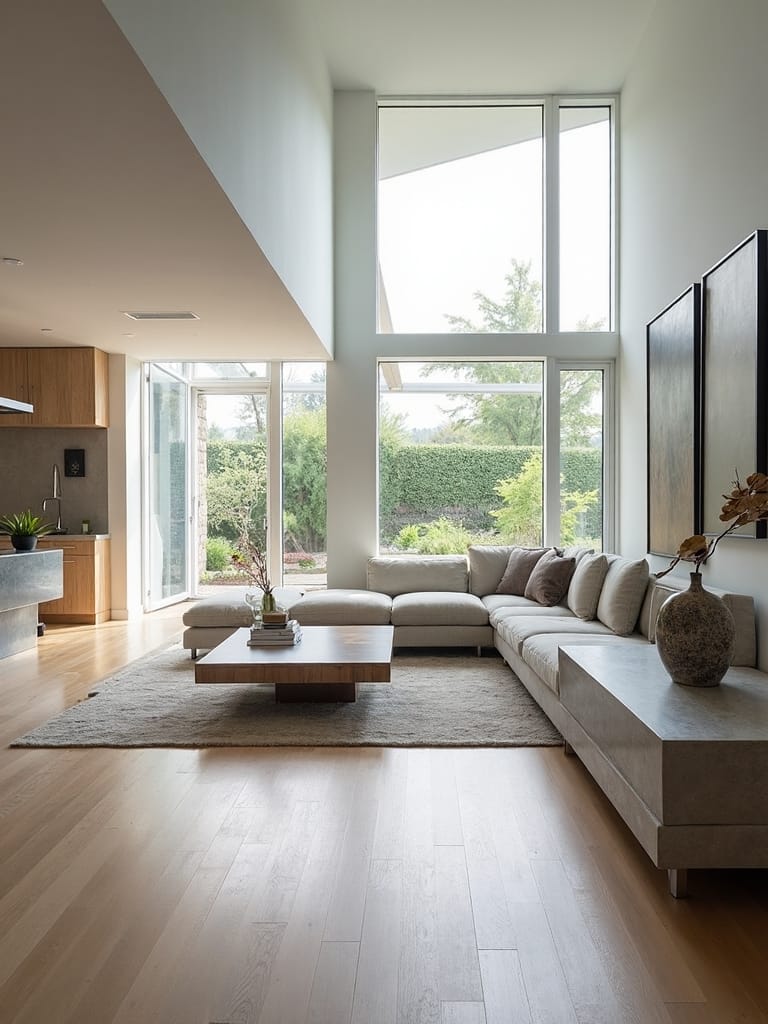
Strategic furniture placement serves as the foundation for creating seamless flow in your minimalist living room. In your open floor plan, arrange your seating area with sofas and chairs facing each other to encourage conversation.
Define your space with a large area rug, and position modular furniture to maximize seating without cluttering pathways. Add strategic lighting and occasional tables to support natural movement throughout the room.
Define Zones With Area Rugs
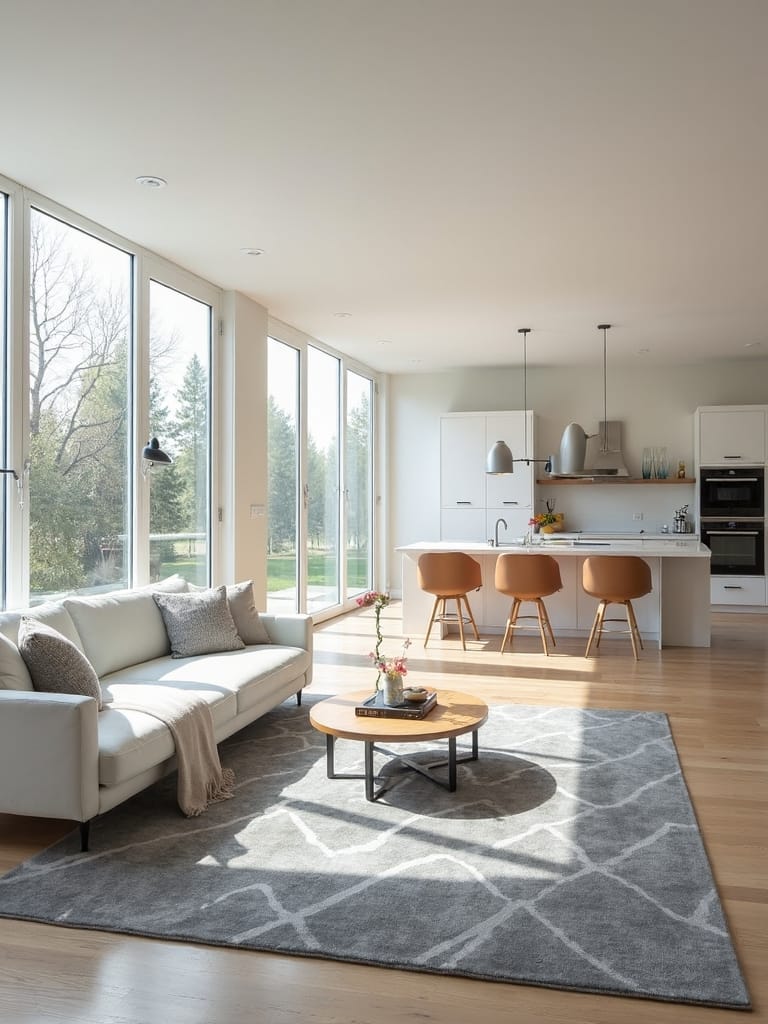
Area rugs work as powerful visual anchors to establish distinct functional spaces within your open concept living room.
You’ll create an open yet organized living area by placing rugs strategically to define your seating arrangements, dining space, or reading nooks.
Choose rugs that complement your minimalist design while ensuring they’re proportional to your floor space and furniture groupings.
Balance White Spaces With Natural Textures
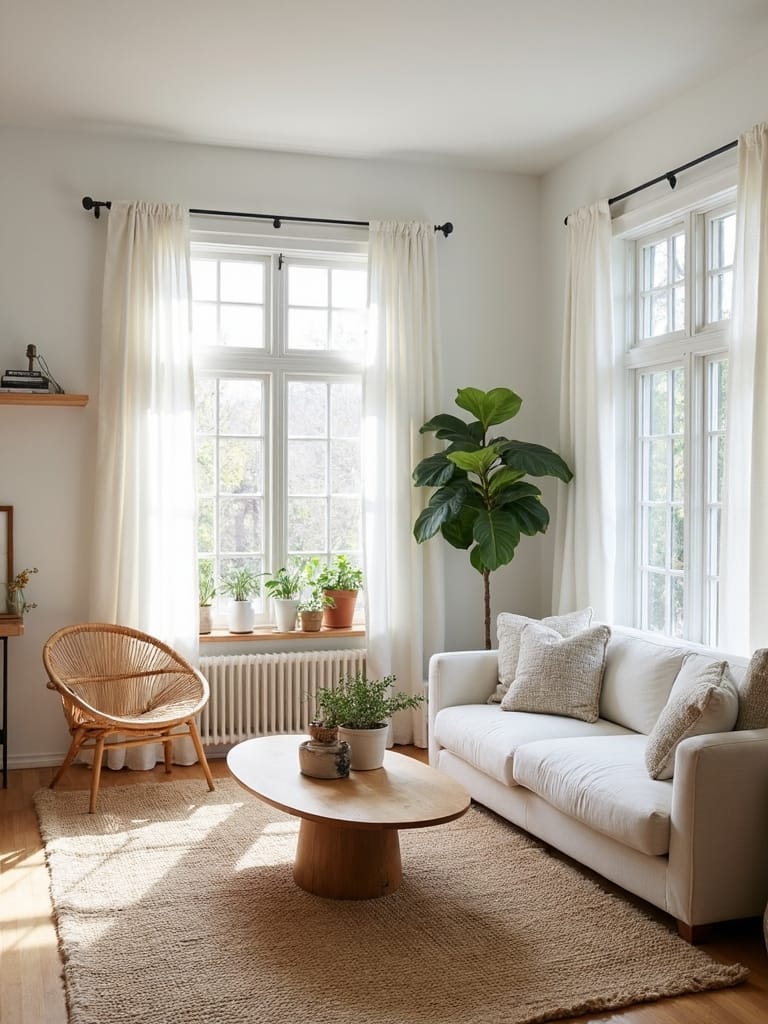
The thoughtful integration of natural textures alters a stark white minimalist space into an inviting, layered sanctuary.
You’ll create depth by incorporating natural wood elements like statement coffee tables and organic textiles such as jute area rugs.
Add sculptural pendant lights made from natural materials, then position large plants as striking organic elements.
Complete the look with carefully chosen decorative pieces in stone or ceramic.
Incorporate Multifunctional Storage Solutions
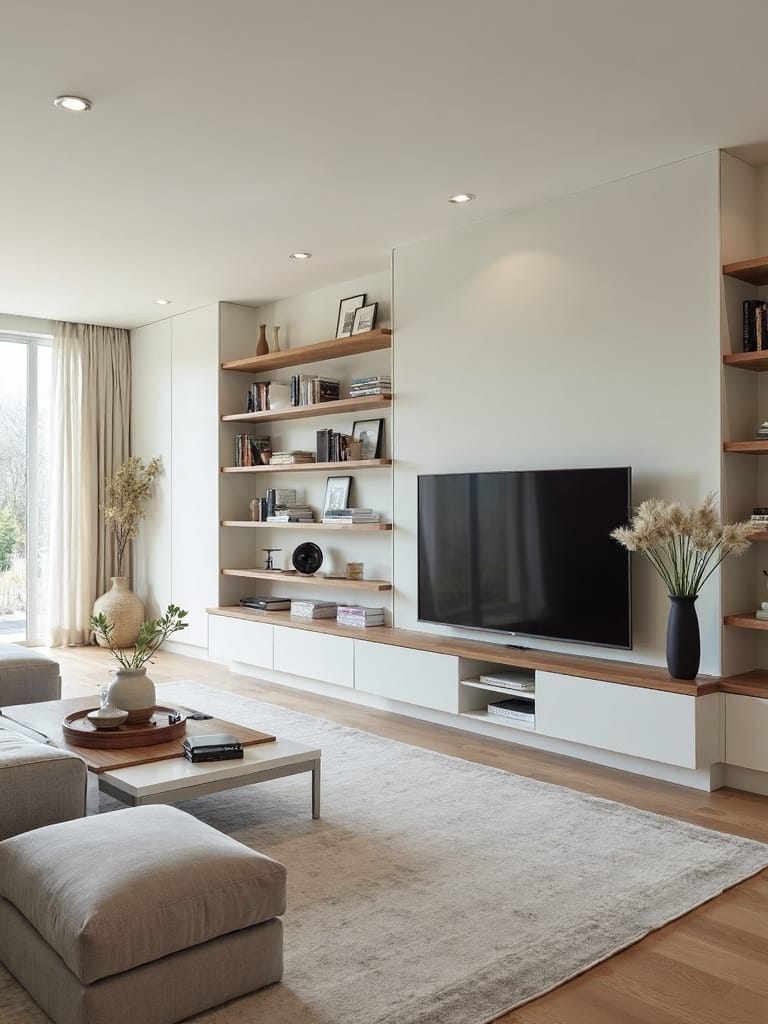
Maintaining a clutter-free environment in your open concept living room becomes effortless when you incorporate clever storage solutions that serve multiple purposes. Consider sleek built-in cabinetry along your walls, complemented by floating shelves for displaying decor.
Add a stylish storage bench or ottoman for extra seating, while a multifunctional coffee table and console table can discreetly house your everyday items.
Maximize Vertical Space With Floor-To-Ceiling Elements

Building upward changes your minimalist living room into a visually striking space that commands attention from floor to ceiling. Install dramatic built-in bookcases to create an eye-catching focal point, while strategically placed pendant lights and slender floor lamps draw gazes upward.
Complete the vertical design with tall potted plants and floor-to-ceiling curtains, refashioning your room into a sophisticated, heightened sanctuary.
Add Warmth Through Wood Accents
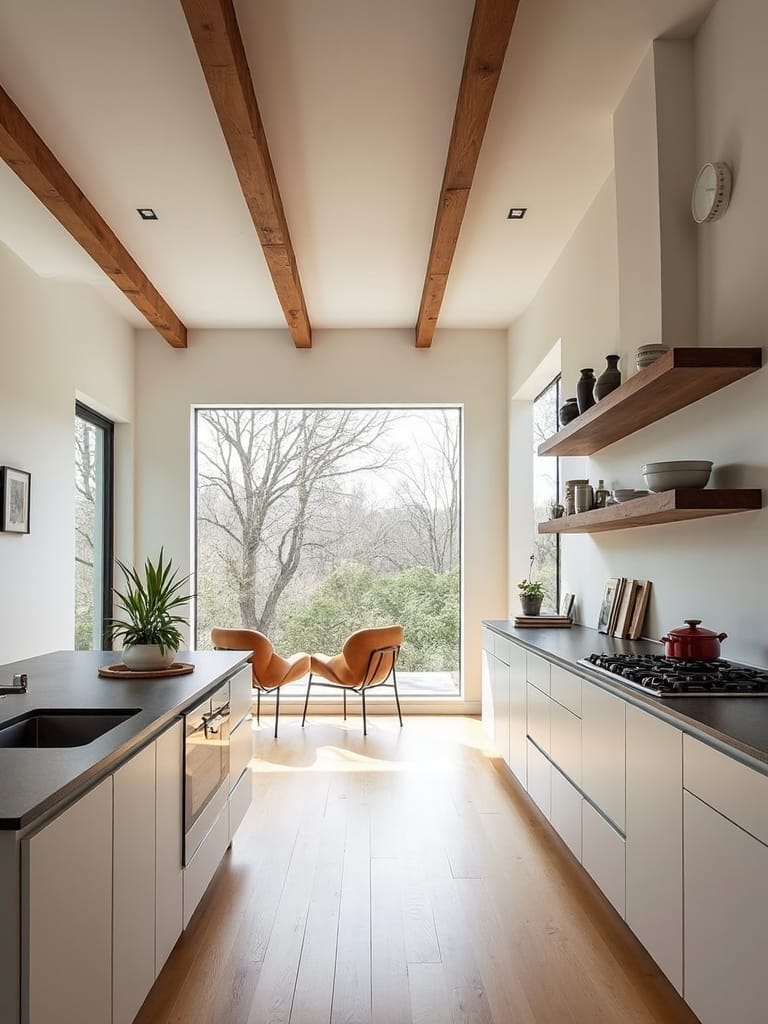
Naturally rich and inviting, wood accents modify minimalist spaces from stark to serene while maintaining clean design principles. You’ll reshape your open-concept living room by incorporating a sleek wood coffee table that anchors your neutral color palette.
Layer different wood tones through floating media consoles, side tables, and dining chairs to create visual flow and warmth throughout the space, especially when bathed in natural light.
Use Statement Lighting as Focal Points
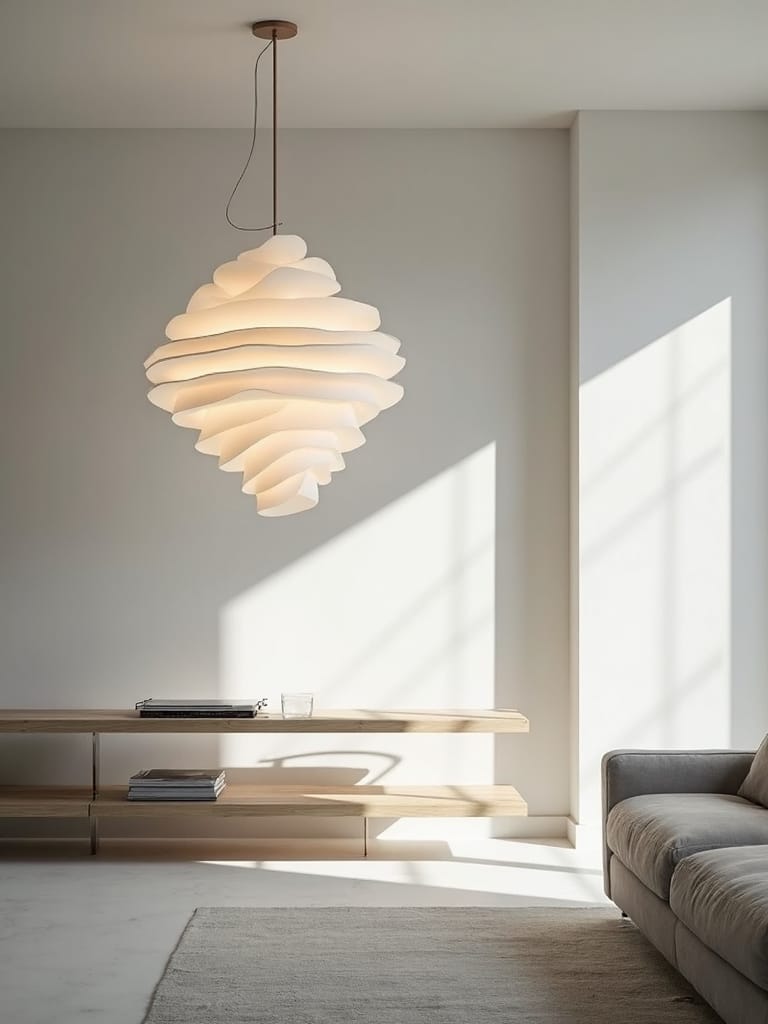
Statement lighting modifies open-concept minimalist spaces from basic to breathtaking, much like how wood elements bring natural warmth.
In your living room, select a large pendant light or modern chandelier as your focal point, positioning it where it’ll command attention in the open space. You’ll find that a well-chosen Statement Piece can define zones while maintaining your room’s airy feel.
Connect Indoor and Outdoor Spaces

Creating a seamless flow between your indoor and outdoor spaces alters a minimalist living room into an expansive oasis. Install large windows or sliding glass doors to maximize natural light, while incorporating natural elements like potted plants to bridge both areas.
Position your furniture to frame outdoor views, and select sheer window treatments that won’t obstruct the scenery. Match your color palette and material choices across both spaces for harmonious integration.
Layer Neutral Tones for Depth

While outdoor elements bring nature into your space, the thoughtful layering of neutral tones adds sophisticated depth to a minimalist living room.
Build your neutral color scheme by starting with shades of white as your base, then incorporate soft colors like beige, cream, and warm gray. Layer different textures in your neutral palette to create visual interest and add depth to your neutral space.
Choose Low-Profile Furniture
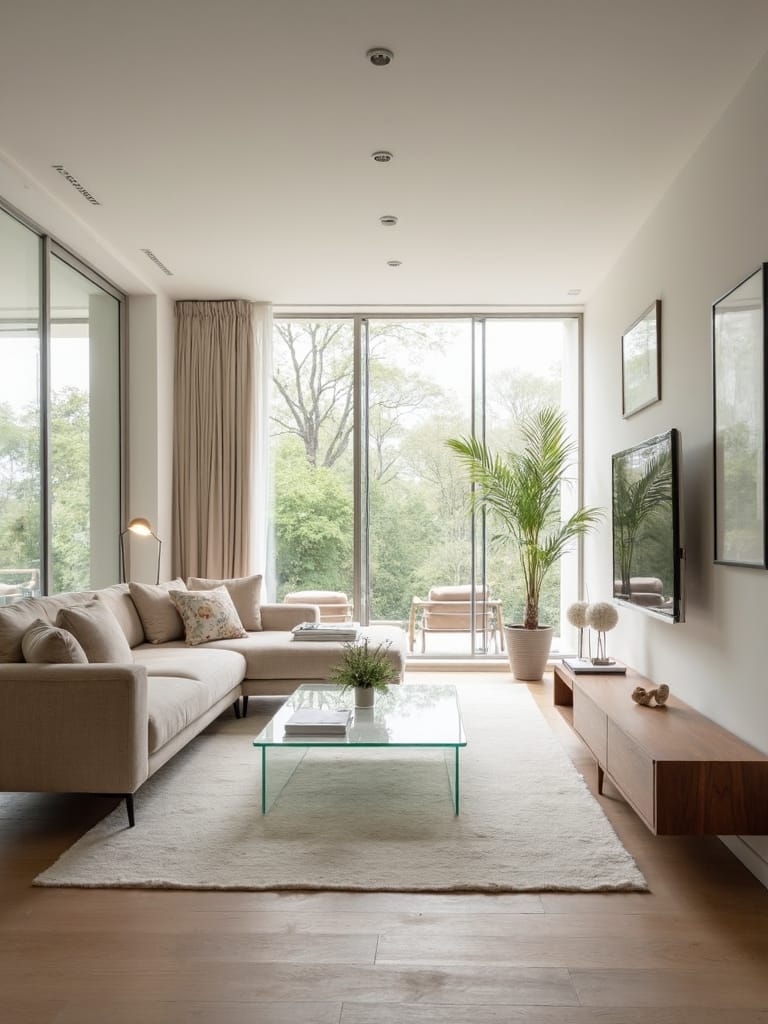
Low-profile furniture serves as a cornerstone of minimalist open-concept living rooms, creating an unobstructed flow throughout your space. Choose sleek, slim pieces like floating sofas and leggy coffee tables to maintain visual openness.
You’ll want to avoid bulky, overstuffed furniture that can make your living room feel cramped. Instead, opt for streamlined pieces, including a minimalist TV stand, to maximize your open floor plan.
Integrate Hidden Storage Solutions
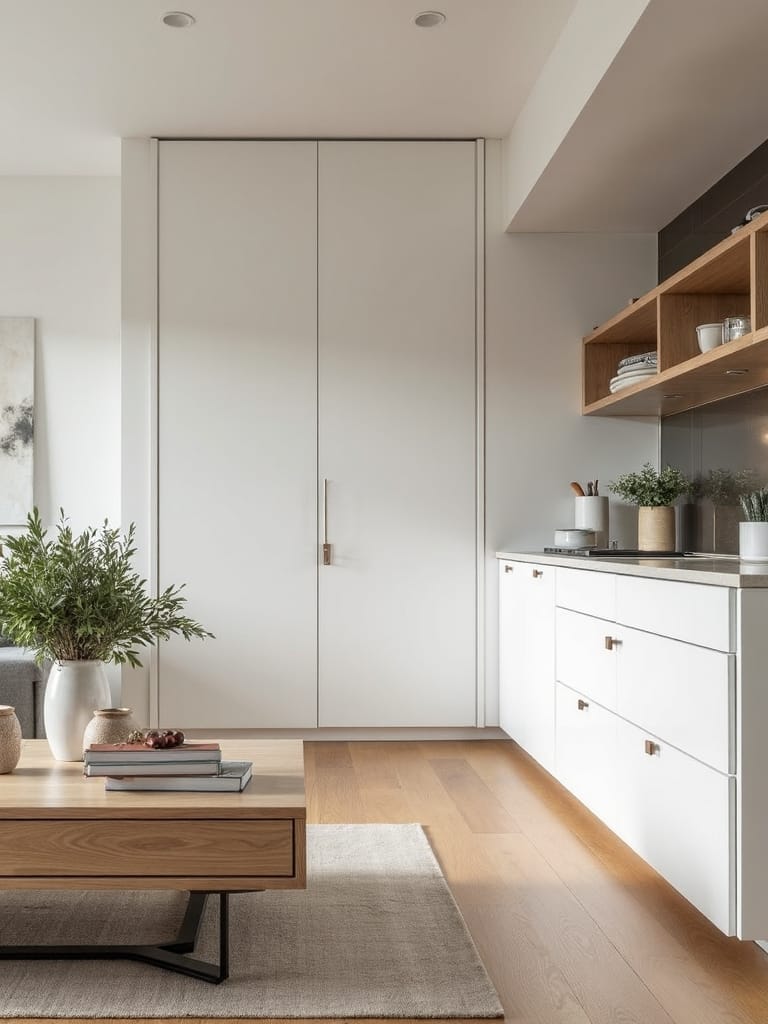
A truly minimalist living room extends beyond just selecting streamlined furniture – it requires smart storage solutions that keep everyday items out of sight.
Make the most of your space by incorporating hidden storage compartments in ottomans and coffee tables. Install wall-mounted shelves and floating media consoles to maximize floor space, while strategically placed storage baskets behind furniture provide discreet organization without compromising your room’s clean aesthetic.
Create Visual Balance With Symmetry

Symmetrical design serves as the cornerstone of minimalist living spaces, creating a sense of visual harmony that instantly soothes and relaxes. Start by arranging matching furniture pieces equidistant from your living room’s focal point, like the fireplace or entertainment center.
Center a large area rug beneath your seating arrangement, then balance decorative elements with identical lamps, artwork, and accessories on either side.
Add Character With Raw Materials
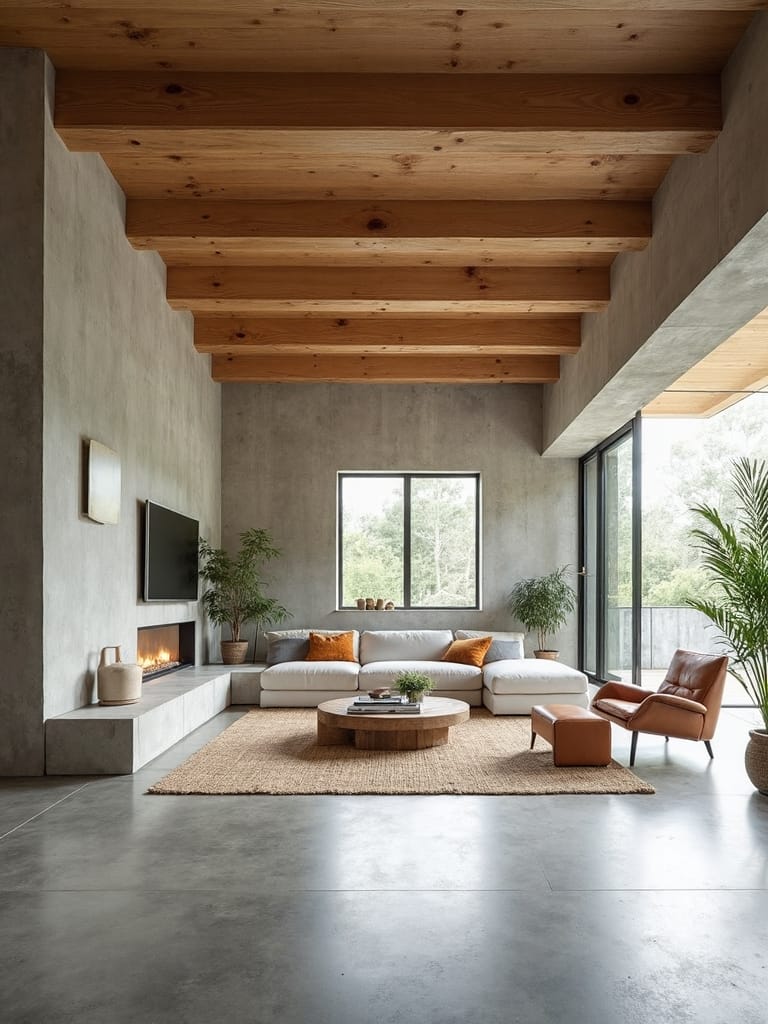
Raw materials serve as the perfect foundation for adding depth and personality to your minimalist living space without compromising its clean aesthetic. Incorporate exposed brick, concrete, or wood elements to create texture and visual interest throughout your room.
A statement-making fireplace with stone or metal surround becomes a striking focal point, while sculptural lighting fixtures with metallic finishes complement these raw materials beautifully.
Select Sculptural Statement Pieces
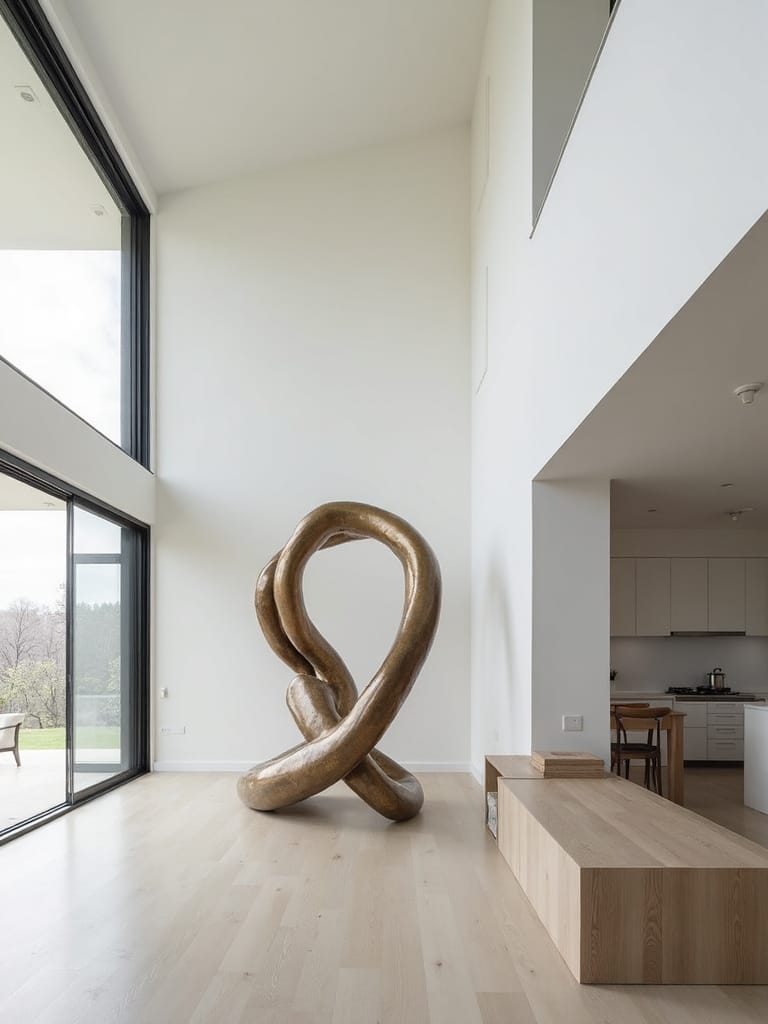
While minimalism celebrates simplicity, strategically placed sculptural pieces can alter your living room into an engaging gallery-like space.
Transform your minimalist living room with a bold pendant light that commands attention or a uniquely shaped floor lamp that serves as a focal point. Add visual interest through curved seating elements, frameless geometric mirrors, and statement decorative objects that bring organic forms to your streamlined space.
Emphasize Clean Lines and Simple Forms

The essence of minimalist design shines through the deliberate use of clean lines and uncomplicated forms in your living space. Select minimalist furniture with streamlined silhouettes, like low-profile sofas and simple coffee tables.
Complement your open concept layout with geometric wall decor, solid-colored area rugs, and built-in storage solutions that maintain visual cohesion while maximizing functionality and style.
Unite Spaces With Consistent Color Schemes

Since open concept spaces flow naturally from one area to another, maintaining a consistent color palette creates visual harmony throughout your living room and adjacent spaces.
Choose a neutral living room base with white walls as your foundation, then layer in two or three complementary colors that’ll unite your modern living room. You’ll find that consistent color choices help define your living space while maintaining an uncluttered, cohesive look.
Incorporate Minimalist Plant Arrangements

Living greenery breathes life into minimalist spaces without compromising clean aesthetics when you select the right plants and display methods. Add sculptural displays by grouping succulents in sleek ceramic planters, or create vertical interest with trailing plants on floating shelves.
Position a striking floor plant like a fiddle-leaf fig in bare corners, and refresh your natural greenery seasonally with rotating potted plants.
Design Around Architectural Features
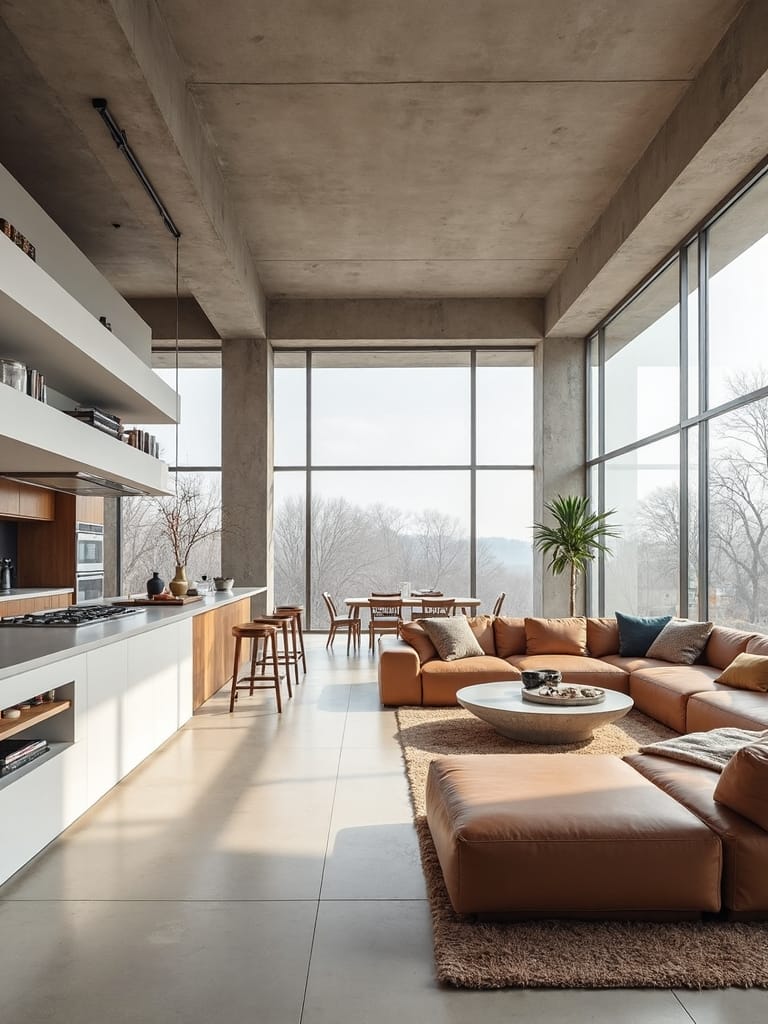
Strategic design choices can remodel prominent structural components into engaging focal points that define your minimalist living room. Let high ceilings, exposed beams, and large windows guide your open layout decisions.
Complement architectural elements with natural materials like wood and stone, and position your furniture to maximize views. Built-in storage solutions that blend with your room’s structure will maintain the minimalist interior’s clean aesthetic.
Maintain Visual Harmony With Scale
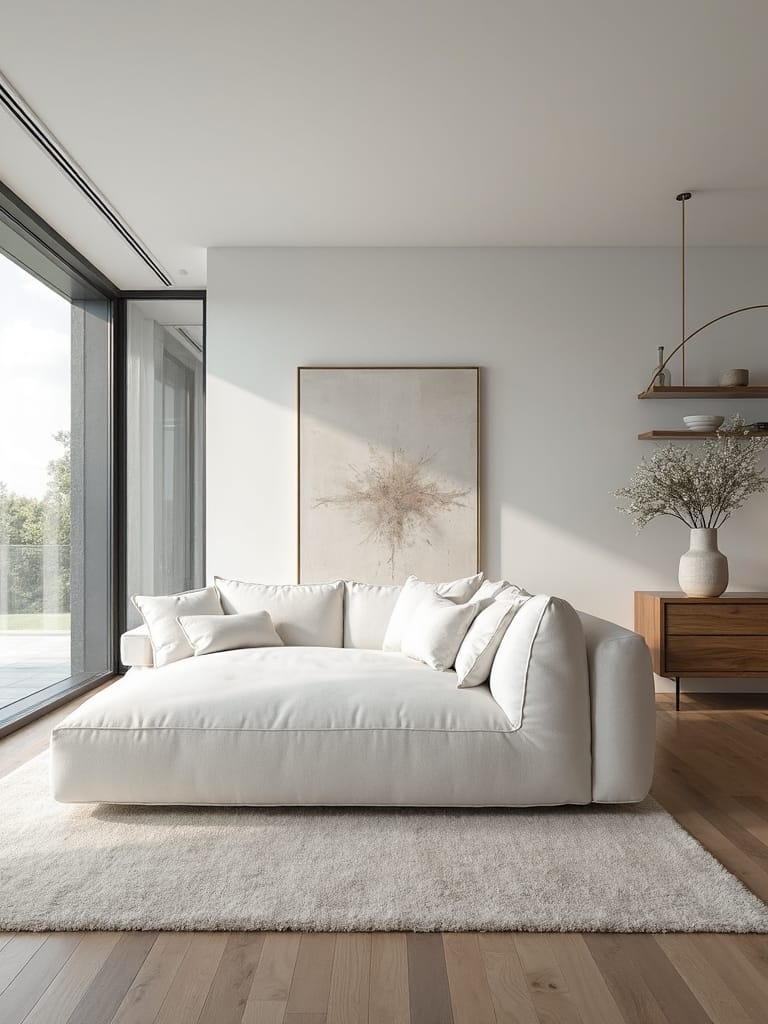
Building on the architectural foundation of your space, proper scaling plays a pivotal role in achieving minimalist perfection. Select furniture pieces that are proportional to your living room’s dimensions, starting with a statement sofa as your anchor piece.
Create visual harmony by choosing balanced accent furniture and artwork that complement the room’s scale while maintaining clear pathways throughout your open-concept layout.
Mix Textures While Keeping Colors Neutral

A thoughtfully layered approach to textures alters your minimalist living room from stark to sophisticated while maintaining a serene neutral palette.
Combine sleek furniture with textured elements like velvet pillows and shag rugs, then add natural wood accents to bring warmth to your white and gray space. Create visual balance by mixing smooth surfaces like marble with organic materials, and layer throw blankets and pillows in beige and ivory tones.
Float Furniture Away From Walls
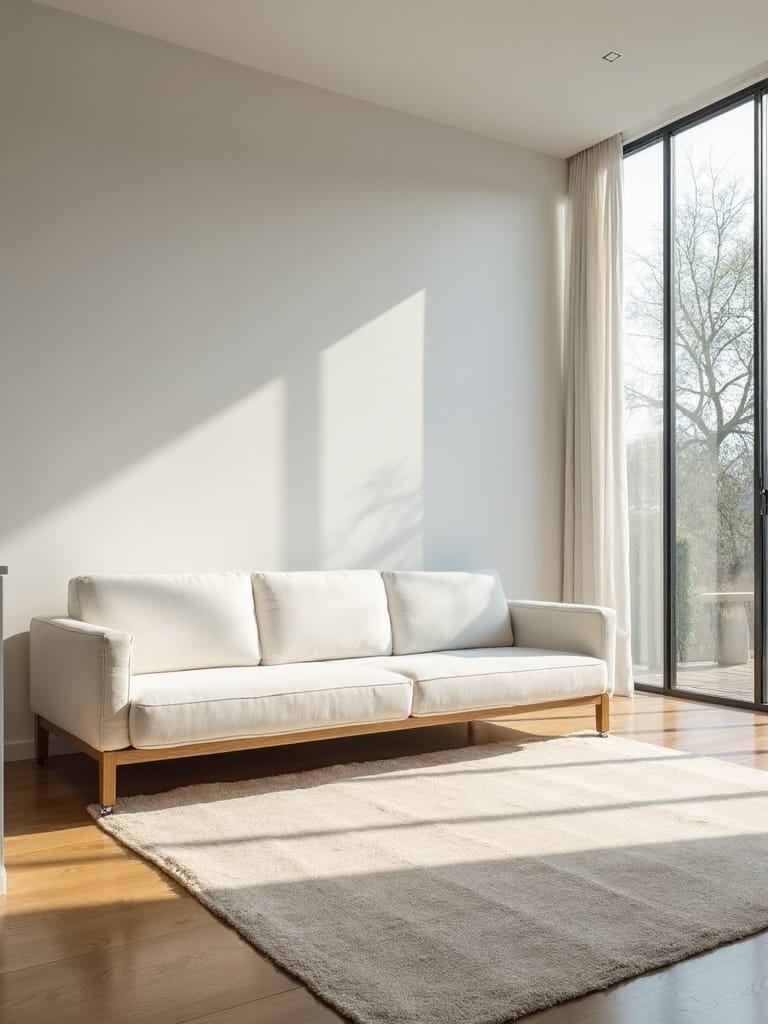
Despite traditional interior design rules, pulling your furniture away from the walls creates an inviting, open flow that defines modern minimalist spaces.
When planning your living room’s open floor plan, position seating arrangements towards the center to enhance visual balance. Establish your focal point first, then arrange floating furniture around it. Anchor the entire setup with a generously sized area rug for a cohesive look.
Conclusion
You’ve got all the tools needed to metamorphose your living room into an open, minimalist sanctuary that feels both spacious and intentional. Remember to prioritize natural light, create purposeful zones through furniture placement, and maintain visual balance with neutral colors and varied textures. By implementing these design principles strategically, you’ll craft a sophisticated space that flows naturally and supports your lifestyle while maximizing every square foot.

